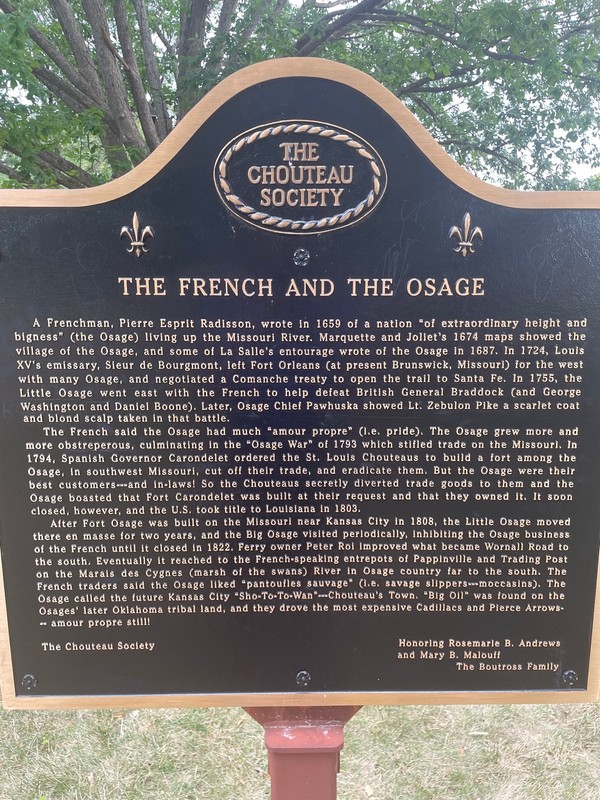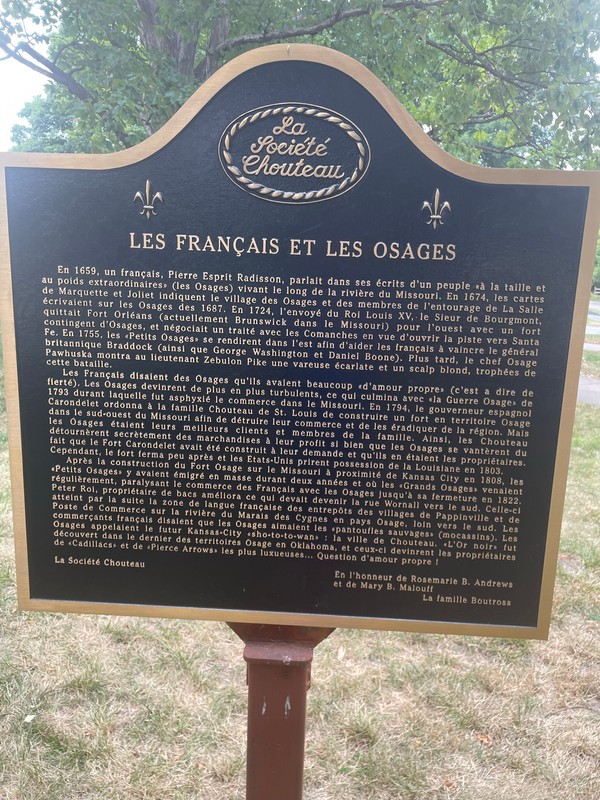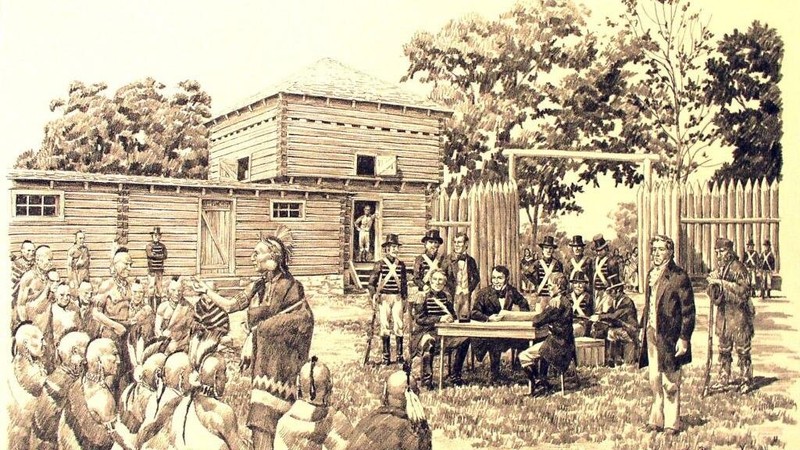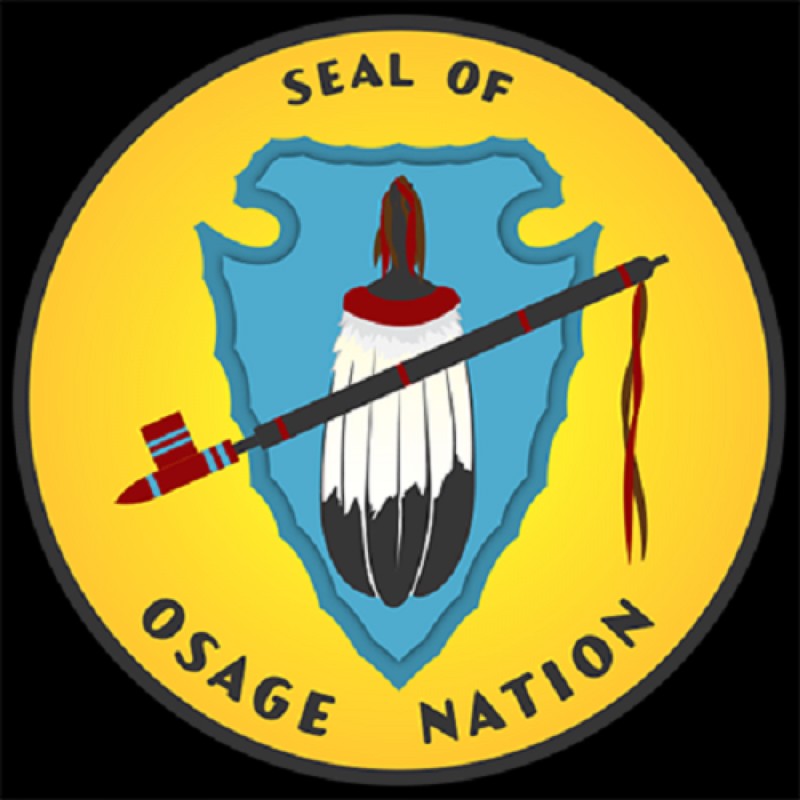The French and the Osage Historical Marker
Introduction
Text-to-speech Audio
Located in original Osage Nation territory, this historical marker was placed in Kansas City by The Chouteau Society to commemorate the influence of the French relationship with the Osage in the Kansas City area. The French first arrived in the area in the 1700s and as a result of successful trade, the Osage became a dominant force. After multiple wars, the establishment of Fort Osage, and increased farming, the French tradesmen moved northward in the early 1800s.
Images
The French and The Osage (English)

The French and The Osage (French)

The signing the Osage Treaty in November 1808 at Fort Osage.

Osage Nation Seal

Backstory and Context
Text-to-speech Audio
France was one of many Colonial European powers that settled America, though each of them approached the challenge differently. The French strategy was to access territory by boat through extensive river systems from the Atlantic Ocean through the St. Lawrence River. From this, they were able to claim the entire Mississippi river drainage basin by building small forts and trading posts as they went along the river. Aside from a few towns in Canada, the French were not interested in ferrying their own people en masse across the Atlantic to fully settle the lands they had claimed. Instead, the French opted to exercise minimal control over their frontiers in the south, rarely straying far from the Mississippi river and its tributaries. They were far more interested in the economic possibilities the “new world” offered, and they exploited these by forming and maintaining positive relationships with groups of Native Americans. They did this by trading manufactured goods like guns and clothes in exchange for valuable furs that were sent back to Europe.
The Osage lived mainly around modern day western Missouri and were one such group that found itself heavily intertwined with the French presence in North America. They gained regional dominance from their relationship with the French. With a steady supply of guns, munitions, and horses the Osage suddenly had an insurmountable martial advantage over their old neighbors and rivals. The French and the Osage supported each other in many armed conflicts against other Native groups, and even other Colonial powers. France and other colonial powers had similar arrangements with other Native American groups. In 1754, France found itself at war with its North American neighbor Great Britain in what would come to be known as The Seven Years War. This was a global conflict that involved fighting in Europe, Asia, the Americas, Asia and Africa with large coalitions on each side. France heavily relied upon their Native American allies like the Osage to provide most of the fighting force in the North American theater of the war. By this point, Osage warriors, and other Native Americans had become extremely adept at guerilla warfare, and these tactics served them well in the early stages of the war.
Ultimately, France lost the war in 1763 and had to give their Canadian holdings to the English as recompense. The Mississippi River drainage basin was then sold to the Spanish, but this was largely in name only as Spain never sent any sizable force to the territory to exercise any real authority or control over the land. Despite the exit of the French Crown, most of the North American Frenchmen remained there and continued their trade relationships with their Native American allies. A near trade monopoly with the Osage and other people groups was held into the early nineteenth century by the French fur trading Chouteau family. This de facto French system remained as the norm in the Mississippi River drainage basin, even well after the land was initially purchased by the United States in 1803 with the Louisiana purchase.
This historical marker reads as follows:
A Frenchman, Pierre Esprit Radisson, wrote in 1659 of a nation "of extraordinary height and bigness” (the Osage) living up the Missouri River. Marquette and Joliet’s 1674 maps show the village of the Osage, and some of La Salle’s entourage wrote of the Osage in 1687. In 1724, Louis XV’s emissary, Sieur de Bourgmont, left Fort Orleans (at present Brunswick, Missouri) for the west with many Osage, and negotiated a Comanche treaty to open the trail to Santa Fe. In 1755, the Little Osage went east with the French to help defeat British General Braddock (and George Washington and Daniel Boone). Later, Osage Chief Pawhuska showed Lt. Zebulon Pike a scarlet coat and blond scalp taken in that battle.
The French said the Osage had much “amour propre” (i.e. pride). The Osage grew more and more obstreperous, culminating in the “Osage War” of 1793 which stifled trade on the Missouri. In 1794, Spanish Governor Carondelet ordered the St. Louis Chouteaus to build a fort among the Osage, in southwest Missouri, cut off their trade, and eradicate them. But the Osage were their best customers – and in-laws! So the Chouteaus secretly diverted trade goods to them and the Osage boasted that Fort Carondelet was built at their request and that they owned it. It soon closed, however, and the U.S. took little to Louisiana in 1803.
After Fort Osage was built on the Missouri near Kansas City in 1808, the Little Osage moved there en masse for two years, and the Big Osage visited periodically, inhibiting the Osage business of the French until it closed in 1822. Ferry owner Peter Roi improved what became Wornall Road to the south. Eventually it reached to the French-speaking entrepots of Pappinville and Trading Post on the Marais des Cygnes (march of the Swans) River in Osage county far to the South. The French traders said the Osage liked “pantoufles sauvage” (i.e. savage slippers – moccasins). The Osage called the future Kansas City “Sho-To-To-Wan” – Chouteau’s Town. “Big Oil” was found on the Osages’ later Oklahoma tribal land, and they drove the most expensive Cadillacs and Pierce Arrows – amour proper still!
Cite This Entry
Stahly, Nichole, Clio Admin, and Charles Allen. "The French and the Osage Historical Marker." Clio: Your Guide to History. August 11, 2022. Accessed April 3, 2025. https://theclio.com/entry/154451
Sources
The French and the Osage, The Historical Marker Database . Accessed July 29th, 2022. https://www.hmdb.org/m.asp?m=86416.
ROBERT, ARTHUR. Prologue to the French and Indian War . The Military Engineer, vol. 49, no. 331338 - 340. 44606925.
Worcester, Donald E., and Thomas F. Schilz. “The Spread of Firearms among the Indians on the Anglo-French Frontiers.” American Indian Quarterly 8, no. 2 (1984): 103–15. https://doi.org/10.2307/1184207.
Blaine, Martha Royce. “French Efforts to Reach Santa Fe: André Fabry de La Bruyère’s Voyage up the Canadian River in 1741-1742.” Louisiana History: The Journal of the Louisiana Historical Association 20, no. 2 (1979): 133–57. http://www.jstor.org/stable/4231885.
Hoig, Stan . The Chouteaus: First Family of the Fur Trade. UNM Press, 2010.
Photo by David Trowbridge
Photo by David Trowbridge
https://www.jchs.org/osage-tribe
https://www.cityofgroveok.gov/building/page/tribal-osage-nation

